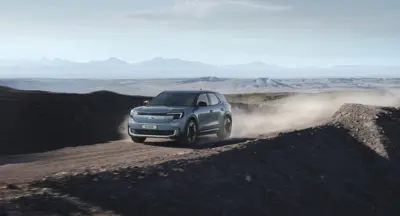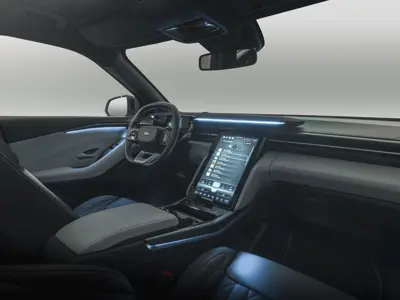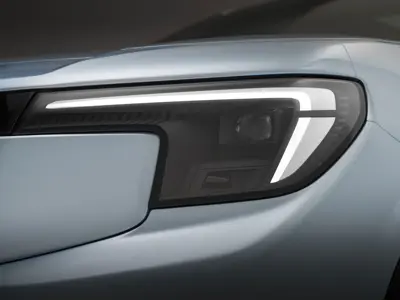Ford Explorer Standard Range RWD
The Ford Explorer Standard Range RWD is an all-electric crossover offering a WLTP range of up to 380 km (236 miles). EVKX.net has all the details you need.
Ford Explorer Standard Range RWD
We've organized this article into specific sections for easier navigation. Click the links below to jump to different areas or read on for the full article. Additionally, we offer an overview of the full specifications, an image gallery, detailed information about charging performance, and some online reviews. Our sections include:
Performance
The Ford Explorer Standard Range RWD offers modest performance with a maximum power of 125 kW (170 hp / 168 bhp) and a total torque of 310 Nm (229 lb-ft). It accelerates from 0 to 100 km/h (0 to 62 mph) in 9 seconds and has a top speed of 160 km/h (99 mph), aligning more closely with traditional internal combustion engine vehicles.
Ford Explorer Standard Range RWD
Battery, Range, and Charging
The high-capacity battery has a gross capacity of 55.0 kWh and a net usable capacity of 52.0 kWh, providing a 3.0 kWh buffer (5.5%) for battery protection. With a nominal voltage of 350 volts, the system is classified as a 400-volt battery system, aligning with industry standards.
According to the WLTP (Worldwide Harmonized Light Vehicles Test Procedure) standard, the vehicle's range is 380 km (236 miles), with an energy consumption rate of 13.7 kWh/100 km (3 mi/kWh).
For more details about the range, see real-world data and range listings on this model’s range and consumption page.
The vehicle supports fast DC charging with a maximum power of 135 kW. Charging from 0% to 100% takes approximately 58 minutes, while a typical 10% to 80% charge takes about 31 minutes with an average charging speed of 70 kW.
Considering an additional 5 minutes for each charging stop due to driving interruptions, the optimal charging range is from 0% to 45%. This results in an effective charging speed, including time lost, of 74 kW, with each charging session taking about 19 minutes and 5 seconds.
In a 1000 km challenge at a constant speed of 120 km/h (75 mph) with an assumed consumption rate of 22 kWh/100 km, the trip would take about 10 hours and 39 minutes, needing six charging stops from 0% to 54%, totaling 139 minutes of charging time.
Onboard Charger
The standard onboard charger supports up to 11 kW for Level 1 and Level 2 AC charging, allowing a full 0–100% charge in about 4 hours and 43 minutes with a standard home setup.
Charge Port
The location of the charge port is on the right rear side. This placement makes it easy to use charging stations that require backing up to connect.
Connector types vary by market: this model uses CCS Combo 1 in North America and CCS Combo 2 in Europe. For complete specifications for all markets, refer to the full specifications.
Drivetrain
The Ford Explorer Standard Range RWD has a rear-wheel drive system supported by one motor on the rear axle.
The motors used are Induction Motors.
Suspension
The front suspension is MacPherson Strut, and the rear suspension is Multilink. The standard suspension includes steel springs and hydraulic dampers.
The standard suspension has steel springs with a fixed height but an optional damping adjustment.
Ground clearance with this setup is 202 mm.
You can order Ford Explorer Standard Range RWD with an alternative sport suspension.
The front suspension is MacPherson Strut, and the rear suspension is Multilink. The standard suspension includes steel springs and hydraulic dampers.
The sport suspension has a fixed height and damping characteristics.
Ground clearance with this setup is 163 mm.
Steering
Progressive steering is optional on the Ford Explorer Standard Range RWD, automatically adjusting the steering ratio based on speed for improved control and comfort.
Brakes
The Ford Explorer Standard Range RWD uses disc brakes in the front for superior stopping power and heat dissipation, while drum brakes are employed in the rear for cost efficiency and durability. Drum brakes provide adequate performance for the rear wheels, require less maintenance, and integrate seamlessly with the vehicle's regenerative braking system. This combination ensures optimal braking performance and cost-effectiveness, aligning with the overall efficiency goals of the EV.
The front discs are 358 mm.
Regenerative Braking
The regenerative braking system in this model offers several modes to enhance efficiency and driving experience. The most efficient option is the Automatic Regeneration Mode, where the vehicle coasts when possible and employs regenerative braking to reduce speed as needed.
Manual regeneration is another mode, where regenerative braking is controlled by pressing the brake pedal. The brake system blends in physical brakes only when necessary.
Another option is the Regen on Accelerator Pedal mode where regenerative braking is activated when the driver eases off the accelerator pedal. This system allows the vehicle to slow down and recover energy without the driver needing to press the brake pedal, a feature often referred to as one-pedal driving.
Exterior
The Ford Explorer Standard Range RWD, with dimensions of 4468 mm in length, 1871 mm in width, and 1639 mm in height, falls into the B-SUV segment cars, also known as subcompact SUVs or crossovers, offer a combination of the compact size and maneuverability of B-segment cars with the higher driving position, increased cargo space, and rugged styling of an SUV.
The Ford Explorer Standard Range RWD is available in a total of 7 paint colors, including both solid and metallic options.
The Ford Explorer Standard Range RWD offers multiple wheel options in different sizes, allowing you to customize your vehicle to suit your style and driving preferences. The available tire and wheel combinations include:
- 235/50 tires on 20" rims front and 255/45 tires on 20" rims rear
- 235/45 tires on 21" rims front and 255/40 tires on 21" rims rear
Narrower wheels improve consumption and provide a longer range, while wider wheels offer better traction and handling.
The car has four regular doors and a liftgate.
You can choose an option to have the liftgate electrically powered. You can also have the liftgate with a kick sensor, making it possible to open it by just kicking the foot under the tailgate.
There are two different roof options to select from.
The standard is just a regular roof.
As an option, you can order this model with a panoramic roof. The glass extends most of the roof, and occupants can open the front part. This glass makes the car’s interior feel more spacious and bright, which can improve the mood and comfort of the occupant. It has an electric curtain that occupants can use to protect against the sun.
Additionally, you can order the car with tinted windows from the B-pillar backward, which enhances privacy and reduces glare and heat from the sun, making the interior more comfortable for passengers.
Ford Explorer Standard Range RWD
Interior
Seats
The Ford Explorer Standard Range RWD accommodates five passengers with two front seats and a three-seat bench in the rear.
First Row Seats
The front row offers two seat types to cater to various comfort and style preferences:
The following functionalities are available on the Sport seat:
- Fore-and-aft adjustment (manually adjustable, electrically adjustable as an option)
- Height adjustable headrest
- Heating
The following functionalities are available on the Ergo seat:
- Fore-and-aft adjustment (manually adjustable, electrically adjustable as an option)
- Recline adjustment (manually adjustable, electrically adjustable as an option)
- Height adjustment (manually adjustable, electrically adjustable as an option)
- Heating
- Adjustable lumbar support (electrically adjustable)
- Adjustable thigh support
- Massage
Second Row Seat
The second row features a standard three-seat bench with a 60:40 split, allowing each section to fold separately to increase cargo space.
Additional functionalities include:
Climate System
Two climate system options are available:
- 2-zone climate system: Supports different temperatures for the driver and passenger.
- 3-zone climate system: Supports different temperatures in three zones for the driver, passenger, and backseat.
This model has a heat pump as an option. This heat pump can save significant energy used for heating in cold weather.
Comfort Features
The Ford Explorer Standard Range RWD includes several features to enhance comfort and convenience:
- Wireless Phone Charging
User Interface and Control
This model features a dual-screen setup that separates driver information from infotainment functions.
Key screen details:
- Steering Column Display: A 5.0-inch screen mounted directly on the steering wheel column. This compact display shows essential driving information such as speed, range, and navigation prompts.
- Center Dashboard Touchscreen: A 14.6-inch display located at the center of the dashboard. It serves as the main interface for infotainment, navigation, and vehicle settings.
A optional head-up display projects key driving information—such as speed and navigation cues—onto the windshield for enhanced safety and convenience.
Ford Explorer Standard Range RWD
Steering Wheel
The Ford Explorer Standard Range RWD is equipped with a single type of steering wheel:
- Circular Steering Wheel: This steering wheel provides intuitive control over the infotainment system, allowing you to easily adjust the volume, change music tracks, and manage other key functions.
Mirrors
Both the exterior and interior mirrors use conventional mirror technology to provide a clear view of the area behind the vehicle.
Infotainment
Navigation System
With the common.optionalfeature in-car navigation system, you have all the assistance you need to reach your destination effortlessly.
Phone Mirroring
The Ford Explorer Standard Range RWD supports Android Auto and Apple CarPlay, allowing you to mirror your phone's screen on the car's display. This functionality enables you to run apps like Google Maps or Waze directly from your phone.
Sound System
You can choose between two sound systems for the Ford Explorer Standard Range RWD:
- Sound system: Features six speakers and delivers a maximum output of 140 watts.
- B&O Soundsystem: Features ten speakers and delivers a maximum output of 480 watts.
Additionally, the model includes 4 USB-C connections as standard.
Mobile App
The Ford Explorer Standard Range RWD comes with a dedicated mobile app, available for both Android and iOS devices, allowing you to manage and monitor your vehicle remotely. The app offers a wide range of features designed to enhance your driving experience:
Lights
The Ford Explorer Standard Range RWD comes equipped with advanced LED Matrix headlights. This adaptive system divides the traditional single headlight beam into multiple smaller rays, allowing the light controller to selectively turn them on and off to avoid dazzling other drivers. For enhanced safety, the headlights also include corner lights that illuminate the side when turning.
The taillights use LED technology, ensuring both high visibility and energy efficiency.
Ford Explorer Standard Range RWD
Advanced Driver Assistance Systems
The Ford Explorer Standard Range RWD features a range of standard and optional advanced driver assistance systems (ADAS) designed to enhance safety and comfort.
Efficiency Assist: A Standard feature that helps drivers anticipate driving conditions and conserve energy.
Safety Systems
Anti-lock Braking System (ABS): Standard on the Ford Explorer Standard Range RWD, this system prevents the wheels from locking during braking.
Electronic Stability Control (ESC): Standard on the Ford Explorer Standard Range RWD, this system improves the vehicle's stability and handling during sudden maneuvers or on slippery road conditions.
Lane-Keeping Assist (LKA): Standard on the Ford Explorer Standard Range RWD, this system helps prevent the vehicle from drifting out of its lane.
It also includes a Lane Departure Warning system to alert the driver if the vehicle veers out of the lane.
Front Cross Traffic Assist (FCTA) : Standard on the Ford Explorer Standard Range RWD, this driver assist system that helps drivers detect oncoming traffic when crossing an intersection or turning left or right from a stopped position.
Forward Collision Warning (FCW): Standard on the Ford Explorer Standard Range RWD, this driver assist system helps drivers avoid or mitigate frontal collisions.
Automatic Emergency Braking (AEB): Standard on the Ford Explorer Standard Range RWD, this system autonomously applies the brakes to prevent or reduce the severity of a collision if the driver does not react in time.
Automatic Emergency Steering (AES): Standard on the Ford Explorer Standard Range RWD, this system assists in avoiding collisions by automatically steering the vehicle in an emergency.
Blind-spot Monitoring (BSM) : Optional on the Ford Explorer Standard Range RWD, this side assist system helps to detect traffic in blind spots.
Driving Automation
The Ford Explorer Standard Range RWD offers driving automation at levels 1 or 2, depending on the equipment level.
With the level 1 system, you get the following driving automation features.
With the optional Assistantpackage level 2 system, you get additional driving automation features to the ones listed above:
- Lane Centering Assist (LCA) /AutoSteer: keeps the car in your lane and slows down if needed in traffic. The system limits how long you can drive without touching the steering wheel.
- Automatic parking.
Safety
Security and Access Technologies
The Ford Explorer Standard Range RWD is equipped with advanced security features to protect you and your vehicle. These include:
- Keyless Entry and Start: With the standard keyless start and optional keyless entry, you can unlock and start the vehicle seamlessly without removing the key from your pocket or bag.
Cargo Capacity and Towing Ability
The trunk offers a cargo capacity of 536 liters (18.9 CU FT). With the rear seat folded down, this expands to 1422 liters (50.2 CU FT).
On the roof, you can load up to 75 kg (165.3 lbs).
The vehicle’s maximum weight is 2490 kg (5490 lbs), with a base weight of 1932 kg (4259 lbs). This allows for a maximum load of 558 kg (1230 lbs), including the driver and passengers. Note that some options may increase the base weight and reduce the maximum loading capacity.
A towbar can be added to the vehicle. The maximum permissible weight for a braked trailer is 1000 kg (2205 lbs), while for an unbraked trailer, it is 750 kg (1653 lbs).
Availability & Pricing
The Ford Explorer Standard Range RWD had its world premiere on 3/26/2024, with deliveries starting in November 2024.





